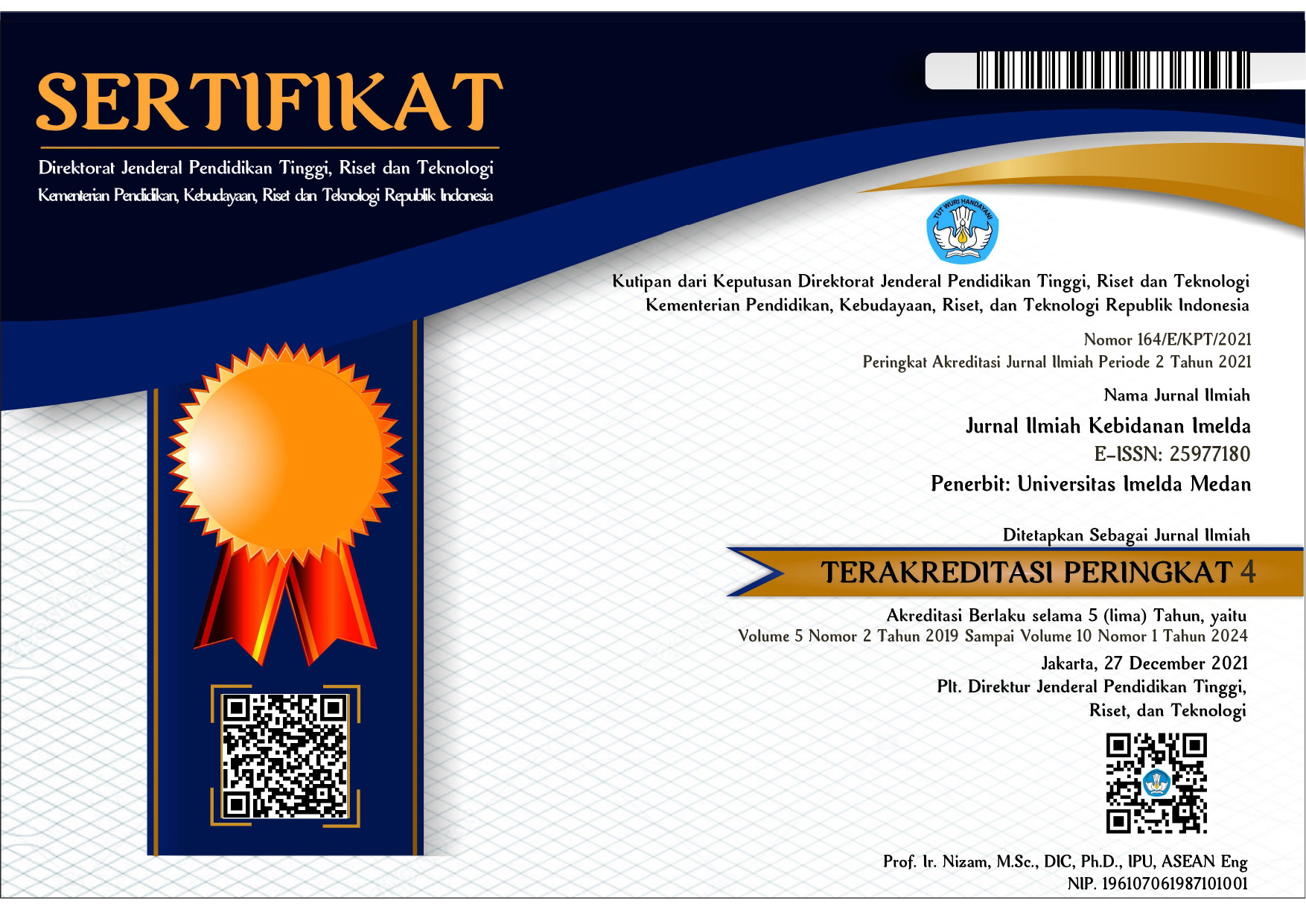GAMBARAN KEJADIAN BABY BLUES PADA IBU POSTPARTUM DI KOTA MEDAN
DOI:
https://doi.org/10.52943/jikebi.v10i1.1335Keywords:
Postpartum Mother, Baby Blouse, PrevalenceAbstract
Postpartum depression in postpartum mothers usually begins with the postpartum blues or baby blues. Baby blues syndrome is often considered not very important and is arely considered, because even if many experience it, it is often only seen as a side effect of fatigue after giving birth. But basically abby blues are very dangerous for the healt of postpartum mothers and also dangerous for their babies. The purpose of this research is to find out how the prevalence of abbay blues in the city of Medan, North Sumatera. The samples taken in this study were 80 postpartum mothers. The method used is descriptive quantitative research with primary data collection through questionnaire interviews according to the Edinburgh Postpartum Depression Scale. The result of study can be stated that many mothers experience baby blues as much as 92,5% of respondents. Mothers who experienced the incidence of baby blues from the age of <20 were 56,25%. As well as the incidence of postpartum blues in primipadra mothers as much as 72,52%. Symptoms of postpartum blues are characterized by the presence of disturbances such as reaction of depression or sadbess, crying,irritability, anxiety, feeling unstable, tending to blame oneself, impaired appetite.
References
D. Indriastuti and T. Tahiruddin, “Hot Bath Therapy for Postpartum Mothers: the Ethnocaring Practice in the Muna Tribe, Southeast Sulawesi, Indonesia,” Public Heal. Indones., vol. 5, no. 4, pp. 105–115, 2019, doi: 10.36685/phi.v5i4.312.
A. Wasiah, “Family Support for Postpartum Blues,” Media Komun. Ilmu Kesehat., vol. 12, no. 02, pp. 70–76, 2020.
P. Label, “About the Epds,” vol. 150, pp. 3–6, 1987.
T. Skor, A. Di, and H. Hubungi, “Machine Translated by Google Skala Depresi Pascanatal Edinburgh ( EPDS ) Machine Translated by Google Penilaian Skala Depresi Postnatal Edinburgh ( EPDS ) & Informasi Lainnya,” vol. 150, 1987.
S. Halima, S. Supriyadi, and E. N. Deniati, “Dukungan Sosial Terhadap Kejadian Baby Blues di Wilayah Kerja Puskesmas Krejengan Kabupaten Probolinggo,” Sport Sci. Heal., vol. 4, no. 3, pp. 219–228, 2022, doi: 10.17977/um062v4i32022p219-228.
N. Tarisa, F. Octarianingsih, F. Ladyani, and W. Pramesti, “Distribusi Frekuensi Kejadian Postpartum Blues Pada Ibu Pascamelahirkan,” J. Ilm. Kesehat. Sandi Husada, vol. 12, no. 2, pp. 1057–1062, 2020, doi: 10.35816/jiskh.v12i2.430.
H. Putri and F. Putri, “How To Cope With Baby Blues: a Case Report,” J. Psychiatry Psychol. Behav. Res., vol. 3, no. 1, pp. 13–15, 2022, doi: 10.21776/ub.jppbr.2022.003.01.4.
A. M. Jayasima, S. M. Deliana, and M. I. Mabruri, “Postpartum Blues Syndrome Pada Kelahiran Anak Pertama,” Dev. Clin. Psychol., vol. 3, no. 1, pp. 1–4, 2014.
M. Ulfa, L. P. Monica, and W. Wibisono, “The Familiarization of Post-Partum Blues Syndrome to Pregnant Women Through Health Promotion,” J. Community Serv. Heal., vol. 3, no. 1, pp. 011–014, 2022, doi: 10.26699/jcsh.v3i1.art.p011-014.
W. Desiana and T. Tarsikah, “Screening of Post Partum Depression on the Seventh Day Puerperium,” Indones. Midwifery Heal. Sci. J., vol. 5, no. 2, pp. 198–208, 2021, doi: 10.20473/imhsj.v5i2.2021.198-208.
M. Dwianna Widyaningtyas, “Pengalaman komunikasi ibu dengan baby blues syndrome dalam paradigma naratif,” J. Manaj. Komun., vol. 3, no. 2, pp. 202–213, 2019.
K. Pratiwi and E. Khoirunnisa, “Gambaran Kejadian Baby Blues Syndrome pada Postpartum Ibu Berdasarkan Sosiodemografi Selama COVID-19,” pp. 19112–19118, 2020.
O. Eisen, S. Rang, and A. Talvari, “Масс-Спектры Монозамещенных Циклопентеновых Уелеводородов 1. 1- И З-Н-Алкил-1-Циклопентены,” Eesti NSV Tead. Akad. Toim. Keemia. Geoloogia, vol. 23, no. 4, p. 307, 1974, doi: 10.3176/chem.geol.1974.4.04.










